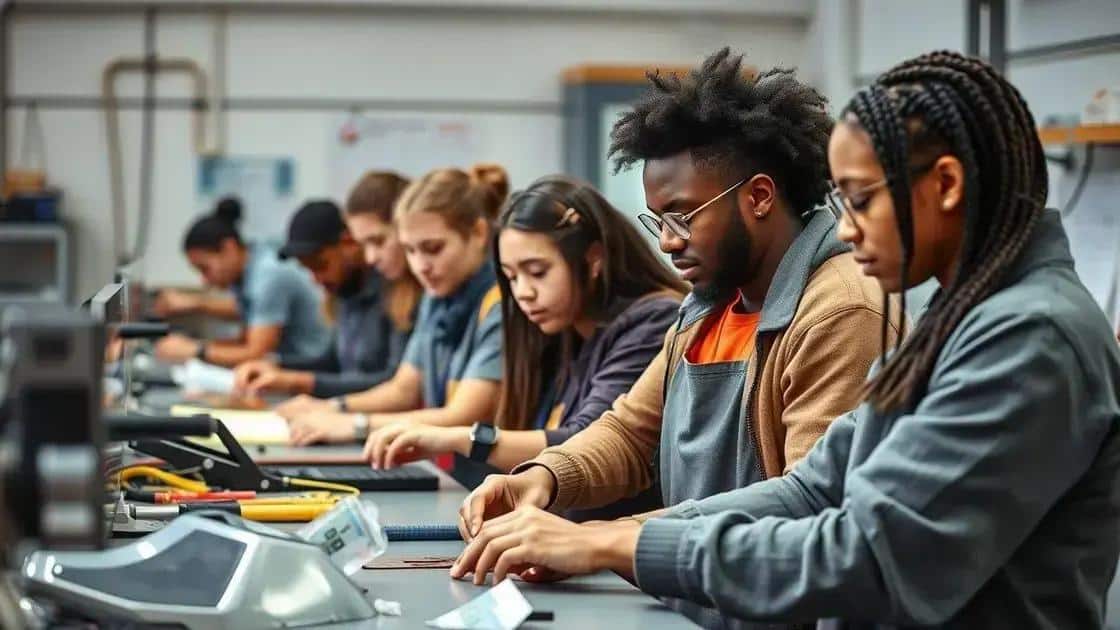Vocational education expansion: unlocking new opportunities

Vocational education expansion enhances workforce readiness by providing practical skills, aligning curricula with industry needs, and integrating technology, making graduates highly employable and prepared for today’s job market.
Vocational education expansion is reshaping the landscape of career training, offering innovative pathways to success. Have you ever thought about how this could change your job prospects? Let’s dive in!
What is vocational education?
Vocational education refers to training programs designed to equip individuals with specific skills for particular careers. This form of education is essential for entering fields that require technical expertise, such as healthcare, trades, and technology.
One of the main goals of vocational education is to enable students to become job-ready quickly. By focusing on practical skills and knowledge, these programs help learners gain hands-on experience, making them attractive candidates in the workforce.
Key Features of Vocational Education
Vocational education often emphasizes real-world applications, which can be particularly beneficial for those who prefer learning by doing rather than through traditional academic routes. Programs can vary widely in terms of duration and focus, catering to diverse job markets.
- Hands-on training and practical experience
- Industry-recognized certifications
- Shorter program durations compared to traditional college degrees
- Strong ties with local employers and job placement opportunities
As students navigate their educational journeys, they often find that vocational education opens doors to well-paying jobs that are in high demand. This approach not only helps the individual but also supports economic growth by creating a skilled workforce.
Furthermore, vocational education is adaptable to changing job markets. Programs are regularly updated to reflect the latest industry standards and technological advancements, ensuring that graduates are equipped with current skills.
The impact of vocational education expansion on the workforce
The impact of vocational education expansion on the workforce is significant and multi-faceted. As more individuals seek vocational education, they gain practical skills that meet the demands of various industries. This trend not only enhances individual career prospects but also strengthens entire sectors by providing skilled labor.
When vocational education expands, it leads to a more prepared workforce. Students acquire specific knowledge and skills that are in high demand, making them valuable to employers. Many programs are tailored to current market needs, ensuring graduates are set to fill critical positions.
Key Benefits of Vocational Education Expansion
One crucial benefit is the reduction in unemployment rates. When individuals complete vocational training, they often enter the job market more equipped than those without specialized skills. This can lead to lower unemployment and higher job satisfaction.
- Improved job readiness among graduates
- Alignment of skills with employer needs
- Increased potential for economic growth
- Support for local businesses seeking skilled workers
Moreover, vocational education can also enhance diversity in the workforce. Programs often attract individuals from various backgrounds, promoting a more inclusive environment in workplaces. This diversity can lead to innovative solutions and a richer exchange of ideas.
As the demand for skilled workers continues to grow, the importance of expanding vocational education becomes even clearer. By investing in such programs, communities can create a sustainable workforce that meets evolving economic demands. The positive effects ripple beyond individual success, influencing overall industry growth and stability.
Key benefits for students and employers

Vocational education offers key benefits that make it attractive for both students and employers. For students, the advantage lies in acquiring practical skills that directly apply to the job market. This type of education equips individuals with the tools they need to succeed in their chosen careers.
Employers also benefit significantly from vocational education expansion. By hiring graduates who have undergone specialized training, companies gain employees who are ready to contribute from day one. This readiness can lead to increased productivity and a lower training cost for businesses.
Benefits for Students
Students pursuing vocational education can enjoy several advantages:
- Shorter program durations compared to traditional degrees, allowing for quicker entry into the job market.
- Hands-on experience that enhances learning and retention of skills.
- Greater job placement rates due to strong industry connections.
- Higher earning potential in skilled trades that are in demand.
Furthermore, vocational education provides a variety of learning paths. Whether students are interested in healthcare, technology, or the arts, there are programs tailored to meet their specific interests and career aspirations.
Benefits for Employers
On the employer side, the advantages are equally compelling:
- Access to a skilled labor pool that meets specific industry needs.
- Reduction in employee turnover, as well-trained graduates are often more satisfied with their roles.
- Potential for innovation, as vocational graduates may bring fresh ideas and perspectives.
- Enhanced reputation as a company that values skilled labor and workforce development.
This mutually beneficial relationship between students and employers enhances the job marketplace significantly. As vocational education expands, both parties can look forward to a brighter future.
Challenges faced in vocational education
Vocational education plays a crucial role in preparing individuals for the workforce, but it also faces several challenges. Recognizing these obstacles is essential for improving programs and ensuring they effectively meet the needs of students and employers.
One major challenge is the perception of vocational education itself. Some people view it as a less prestigious option compared to traditional academic paths. This stigma can discourage students from pursuing technical education, despite the many benefits it offers.
Funding and Resource Limitations
Another significant issue is the lack of adequate funding and resources. Many vocational programs struggle to secure enough financial support to maintain quality training and modern facilities. When resources are limited, it becomes challenging to provide updated equipment and experienced instructors.
- Inadequate facilities for hands-on learning
- Difficulty attracting qualified instructors due to low pay
- Limited access to industry-standard tools and technologies
- Challenges in keeping programs relevant to job market needs
Moreover, aligning curricula with the needs of local industries can be complex. There is a constant demand for skilled labor, and vocational programs must adapt quickly to the changing job landscape to ensure graduates are employable. Failure to do so may result in gaps between the skills taught and those needed by employers.
Enrollment and Retention Issues
Enrollment and retention in vocational programs can also pose challenges. Programs often must compete with traditional colleges, which may appear more appealing to students. To overcome this, vocational education providers need to market their programs effectively and highlight successful career outcomes.
Retention rates can be low if students do not see the immediate benefits of their training. To address this, programs should offer strong internship opportunities and support services, helping students see the connection between their education and real-world employment.
Future trends in vocational education growth
The future of vocational education is bright, with several trends emerging that promise to reshape how students prepare for their careers. As industries evolve, vocational education must adapt to meet the needs of a changing workforce.
One major trend is the increasing incorporation of technology in vocational training. With the rise of online and blended learning, students can access courses no matter where they are. This flexibility allows for a more diverse pool of candidates who may not have been able to attend traditional in-person classes.
Integration of Technology
The use of virtual reality (VR) and augmented reality (AR) in training programs is also on the rise. These technologies allow students to engage in immersive, hands-on learning experiences without the risks associated with real-world settings. Through these simulations, they can practice and hone their skills in a controlled environment.
- Enhanced engagement through interactive learning
- Flexible schedules that accommodate different lifestyles
- Access to a broader range of resources and expertise
- Reduced travel costs for remote learners
In addition, there is a growing focus on collaboration with industries. Vocational programs are partnering with businesses to ensure that curricula remain relevant and up-to-date. This partnership enables students to learn directly from industry experts and gain valuable real-world insights.
Emphasis on Soft Skills
Another trend is the increased emphasis on soft skills training. As employers look for well-rounded candidates, vocational education programs are starting to integrate communication, teamwork, and problem-solving skills into their curricula. This focus ensures that students are not only technically skilled but also ready to work effectively in teams.
Finally, the expansion of apprenticeship programs provides students with practical work experience while they study. These programs offer a seamless transition from education to employment, often leading to higher job placement rates for graduates. With these trends, vocational education is poised for significant growth and evolution in the coming years.
FAQ – Frequently Asked Questions about Vocational Education Expansion
What are the primary benefits of vocational education?
Vocational education provides practical skills, quicker job readiness, and higher earning potential, making graduates attractive to employers.
How does technology play a role in vocational education?
Technology enhances learning through online courses, virtual reality simulations, and access to modern tools, allowing students to gain relevant skills.
What challenges does vocational education currently face?
Challenges include funding limitations, stigma surrounding technical education, and the need for curricula to align with industry demands.
What trends are shaping the future of vocational education?
Future trends include increased industry collaboration, a focus on soft skills training, and the integration of technology to improve learning experiences.





